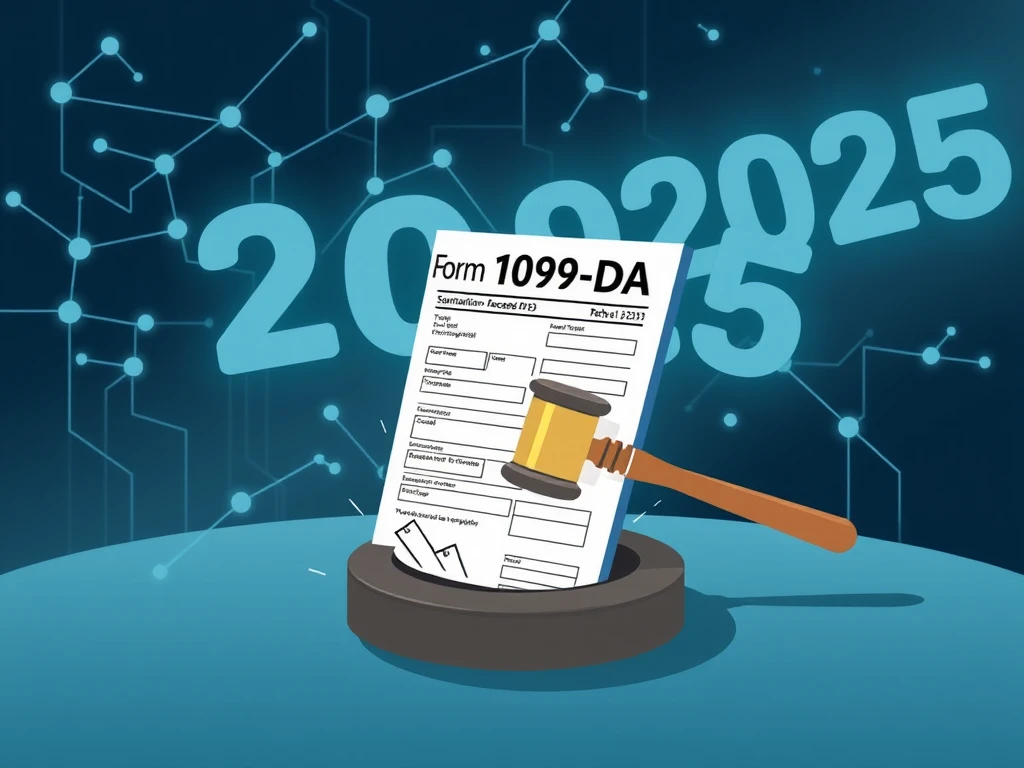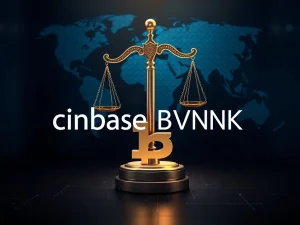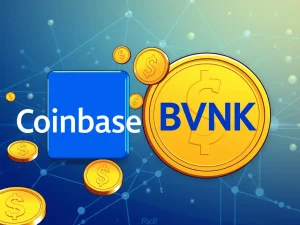Crucial Guide to IRS Crypto Broker Rules: Mastering Form 1099-DA for 2025

Navigating the world of cryptocurrency taxes can feel like deciphering a new language, especially with evolving regulations. Are you ready for the IRS crypto broker rules taking effect in 2025? The introduction of Form 1099-DA marks a significant shift in how digital asset transactions are reported to the IRS. This comprehensive guide will break down everything you need to understand about these new rules, ensuring you’re prepared for the 2025 tax season and beyond. Let’s demystify these changes and empower you to stay compliant.
Understanding the IRS Definition of a Crypto Broker
The cornerstone of these new regulations is the expanded definition of a “broker.” According to the IRS, a crypto broker is any individual or entity that regularly provides services facilitating digital asset transfers. This broad definition aims to capture those with access to crucial transaction details, making them responsible for Form 1099-DA reporting. This rule, rooted in prior IRS guidelines (T.D. 10000 from July 2024) and further refined by T.D. 10021, specifically targets the complexities of decentralized finance (DeFi). The mandate originates from the 2021 Infrastructure Investment and Jobs Act, seeking to modernize tax reporting for the digital age and projected to generate billions in revenue.
Entities now classified as brokers include:
- Digital asset exchanges: This encompasses both custodial and non-custodial platforms that execute cryptocurrency trades.
- Hosted wallet providers: Services managing wallets and verifying user identities fall under this category.
- Digital asset kiosks: Bitcoin ATMs and other physical kiosks dealing in cryptocurrencies are included.
- Crypto payment processors: Platforms that facilitate digital asset transactions and verify buyer and seller identities are considered brokers.
- DeFi front-end service providers: Importantly, only front-end interfaces like token swap interfaces in the DeFi space are classified as brokers. Activities like liquidity provision, staking, and lending are currently exempt from these reporting mandates.
Providers of “unhosted” wallets, where users have complete control over their private keys, are generally exempt, unless their operations mirror those of an exchange. The precise definition of a digital asset broker has been a subject of intense debate since the Infrastructure Investment and Jobs Act of November 2021.
How the IRS Broadens the Definition of “Broker” in Digital Asset Transactions
Section 80603 of the Infrastructure Investment and Jobs Act (Public Law 117-58) expanded the definition of “broker” under Internal Revenue Code Section 6045 to encompass facilitators of digital asset transfers. The IRS regulations broadly define brokers as entities involved in digital asset sales or exchanges. Let’s examine the timeline of these regulations:
Custodial Brokers (June 2024 — Treasury Decision 10000)
Custodial brokers include centralized exchanges (CEXs) holding customer private keys, hosted wallet providers, digital asset kiosks (like Bitcoin ATMs), and certain crypto payment processors. These entities are mandated to report due to their custodial role, enabling transaction tracking.
DeFi Brokers (December 2024 — Treasury Decision 10021)
The December 2024 regulations target front-end service providers in DeFi, such as interfaces connecting users to decentralized exchanges (DEXs). The IRS utilizes a three-layer model (interface, application, settlement) to pinpoint DeFi participants with control or influence, aligning with Financial Action Task Force (FATF) guidance. However, the decentralized nature of DeFi raises privacy and compliance concerns.
Efforts to Repeal the IRS Broker Rule
In March 2025, discussions to repeal the DeFi broker rules gained momentum. Both the Senate (70–27 on March 4) and the House (292–132 on March 11) voted to repeal these rules under the Congressional Review Act (CRA). President Trump has signaled support for this repeal, with his crypto advisor, David Sacks, confirming the administration’s backing. If enacted, this repeal would permanently prevent the IRS from implementing similar regulations, significantly impacting DeFi reporting. The bipartisan support, including 76 Democrats in the House vote, suggests a growing political shift towards supporting crypto innovation, especially under a pro-crypto administration.
Did you know? The finalized IRS crypto broker rules were preceded by five draft Forms 1099-DA and three draft Final Instruction versions. On January 8, 2025, the IRS issued updated 2025 General Instructions for Certain Information Returns, including instructions for Form 1099-DA.
What is Form 1099-DA? The New Crypto Tax Form for 2025
Form 1099-DA, officially titled “Digital Asset Proceeds from Broker Transactions,” is a brand-new tax form introduced by the IRS to standardize the reporting of digital asset transactions, particularly those involving cryptocurrencies. Released on December 5, 2024, it aims to help taxpayers accurately report gains or losses from selling or exchanging digital assets, enhancing the IRS’s ability to track this income. Think of it as a crypto-specific version of Form 1099-B for stocks.
Brokers (like crypto exchanges) are now required to report specific details about your digital asset sales or exchanges to both you and the IRS for transactions in 2025. This includes:
- Customer information: Name, address, and Taxpayer Identification Number (TIN).
- Transaction details: Date and time of each transaction.
- Asset specifics: Amount and type of digital asset sold (e.g., Bitcoin, Ether), including a unique nine-digit code from the Digital Token Identification Foundation (DTIF).
- Gross proceeds: Total amount received in US dollars from the sale.
If you sell or swap crypto through a broker, expect to receive Form 1099-DA to aid in your tax filing. Remember, you remain responsible for reporting all taxable crypto events, even without a form (e.g., trades on non-reporting platforms). Key dates to note:
- Gross proceeds reporting: Begins for transactions on or after January 1, 2025, with reports due in early 2026. You’ll receive your 2025 Form 1099-DA by January 31, 2026, and brokers must file with the IRS by February 28 (or March 31 electronically).
- Basis reporting: Starts for transactions on or after January 1, 2026, including cost basis and gain/loss character for certain brokers.
Why is Form 1099-DA Required?
Before Form 1099-DA, crypto tax reporting was inconsistent and often confusing. Some exchanges issued Forms 1099-MISC or 1099-B, while others provided no forms, leaving taxpayers to manually track trades. This inconsistency hindered accurate reporting and IRS verification. Form 1099-DA is a step towards closing the tax gap and aligning crypto reporting with traditional financial reporting standards.
Did you know? Unlike stock reporting with comprehensive Form 1099-B coverage, crypto’s decentralized nature and lack of universal identifiers presented unique challenges. Form 1099-DA addresses this with the DTIF code and a focus on digital assets, encompassing cryptocurrencies and NFTs, but excluding cash.
How Form 1099-DA Shifts Crypto Reporting
On January 10, 2025, the IRS finalized Form 1099-DA, instructing brokers to use it for reporting specific digital asset transactions from 2025 onwards. Here are key highlights and implications:
Transition Rule for Tokenized Securities
Digital assets previously reported on Form 1099-B, such as tokenized securities, now transition to Form 1099-DA. Sales of tokenized stocks or bonds should now be reported on Form 1099-DA instead of Form 1099-B. A transitional rule for 2025 allows reporting cash sales of tokenized securities on either form, providing flexibility for traditional brokers to update systems by 2026 (Treasury Decision 10000).
Exception in Tokenized Securities Rule
An exception applies to tokenized securities settled on a Limited-Access Regulated Network (LARN). These transactions must still be reported on Form 1099-B, not Form 1099-DA. If a LARN loses regulated status, brokers can continue using Form 1099-B for the rest of that calendar year.
Customer-Provided Acquisition Information
Form 1099-DA includes a new checkbox (Box 8) for brokers who use customer-provided acquisition information to calculate basis. This aligns with regulations allowing brokers to use such data for specific identification and requires disclosure of its use (Treasury Decision 10021).
Did you know? Electronic filing of Form 1099-DA is mandatory through the Information Reporting Intake System (IRIS), not the Filing Information Returns Electronically System (FIRE), as per the 2025 General Instructions.
Noncovered Status
Like Form 1099-B, Form 1099-DA requires brokers to indicate “noncovered security” status in Box 9 if the basis isn’t reported to the IRS. Box 10, previously for explanation, is now reserved for future use, simplifying reporting for assets acquired before basis tracking rules (e.g., pre-2026 purchases).
Number of Decimal Places
The reporting precision for digital asset units sold has increased from 10 to 18 decimal places, reflecting the need for accuracy in digital asset transactions.
Proceeds Clarification
Total proceeds should exclude gross proceeds from the initial sale of NFTs created by the recipient. These creator earnings are reported separately in Box 11c, distinguishing them from secondary sales.
Transfer Date
Box 12b records the date of digital asset transfer into a custodial account. It should be left blank if transfers occurred on various dates.
Qualifying Stablecoins and Specified NFTs
Optional reporting for stablecoins and specified NFTs has specific instructions. For specified NFTs, brokers use code “999999999” in Box 1a and “Specified NFTs” in Box 1b, ensuring distinct tracking of unique assets.
Applicable Checkbox on Form 8949
Brokers must use new codes (G, H, J, K, Y) on Form 1099-DA to align with the recipient’s Form 8949 (Sales and Other Dispositions of Capital Assets), streamlining tax categorization and linking broker reports to tax filings.
Did you know? If asset sales remain unspecified, the IRS will apply first-in, first-out (FIFO), potentially increasing your tax liability.
How IRS Crypto Broker Rules Affect Taxpayers
The new IRS crypto broker rules, effective January 1, 2025, introduce stricter record-keeping and reporting for both brokers and investors, aiming to enhance tax compliance and align digital asset reporting with traditional financial assets. Here’s what taxpayers need to know:
Cost Basis Tracking Per Account
Crypto investors must now track their cost basis – the original purchase price – separately for each account or wallet, moving away from universal tracking. For each transaction, record the purchase date, acquisition cost, and wallet details. Starting in 2025, brokers must report these transactions on Form 1099-DA, similar to stock trade reporting. This change (Treasury Decision 10000, June 2024) tightens loopholes by linking gains to specific accounts.
Specific Identification Required for Transactions
Regulations now require specific identification for each digital asset sale, detailing the purchase date, amount, and cost of the asset sold. Without this, the IRS defaults to FIFO, potentially increasing taxable gains if earlier purchases had lower costs. This change, effective in 2025, necessitates meticulous records to avoid tax surprises. Previously, many investors used average cost basis, a simpler but less accurate method.
Temporary Safe Harbor
The IRS offers a temporary safe harbor (Revenue Procedure 2024-28) to ease the transition. If you used a universal cost basis method, you have until December 31, 2025, to reallocate your basis across accounts accurately. This grace period allows record adjustments without penalties, but action is needed in 2025 as broker basis reporting starts in 2026.
Penalties for Noncompliance
Noncompliance carries consequences. The IRS has increased fines for underreporting crypto income, added interest on unpaid taxes, and will increase audits for mismatched gains and losses in 2025. Notice 2024-56 offers penalty relief for brokers making good faith efforts in 2025, but taxpayers don’t receive the same leniency. Form 1099-DA provides the IRS with clearer data for cross-checking, increasing scrutiny for non-compliant taxpayers.
Impact on Non-Domiciled Taxpayers
The updated crypto broker rules also affect non-domiciled taxpayers, requiring detailed cost basis tracking per account and specific identification of digital asset sales on Form 1099-DA, regardless of residence. For instance, a US citizen in Europe or a foreign national with US-based crypto income must maintain precise records of purchase dates and costs per wallet, facing increased compliance efforts and potential tax obligations on US-sourced gains.
Conclusion: Navigating the New Crypto Tax Landscape
From stricter cost basis tracking to potential penalties, the IRS crypto broker rules represent a significant shift towards aligning crypto with traditional finance. While a temporary safe harbor offers a window to adapt, the message is clear: compliance is no longer optional. The introduction of Form 1099-DA and the expanded definition of crypto broker signal a more rigorous era of crypto tax reporting. As the crypto landscape matures, understanding and adhering to these regulations is crucial for every investor. Stay informed, maintain meticulous records, and ensure your 2025 crypto tax strategy is up to par to navigate this evolving financial frontier successfully.







